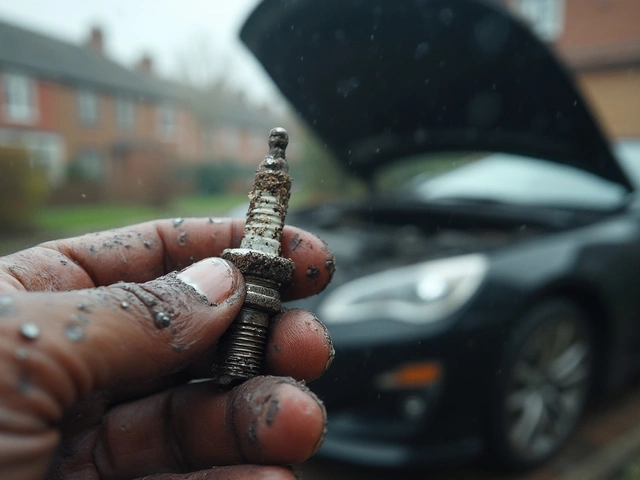You turn the key, the engine coughs awake, and your car moves because a millisecond-long lightning bolt jumped inside each cylinder at exactly the right instant. That tiny bolt is the spark plug. If you’ve ever wondered what it actually does, how to spot when it’s failing, or whether you can change it yourself on the driveway in the rain (hello from Manchester), you’re in the right place. I’ll keep it plain, practical, and specific so you can act with confidence.
TL;DR: What a Spark Plug Does and Why You Care
- A spark plug ignites the compressed air-fuel mix inside a petrol engine by creating a controlled electric spark at the right moment.
- When plugs wear or foul, you’ll feel rough running, hard starts, poor MPG, sluggish acceleration, and misfires (check engine light may flash under load).
- Most petrol cars have one plug per cylinder; diesel engines don’t use spark plugs (they use glow plugs) because they ignite fuel by compression heat.
- DIY is doable with a proper plug socket, torque wrench, and patience; check the gap and torque, and avoid anti-seize on modern plated plugs.
- In the UK, expect £20-£80 for a full set of plugs plus £60-£200 labour depending on engine access and garage rates.
Here’s the simple picture: your ignition coil ramps 12 volts up to around 20-40 kV, then that voltage jumps the plug’s tiny gap (about 0.7-1.1 mm on many modern cars). The spark ignites the air-fuel mix, pressure rises sharply, and the piston is pushed down. The plug also acts as a thermal path, pulling heat out of the combustion chamber into the cylinder head. Its “heat range” controls how fast it sheds heat so the tip runs hot enough to stay clean but cool enough to avoid pre-ignition.
The spark has to happen at the exact right time, every time, thousands of times per minute. A single missed spark (misfire) wastes fuel, makes the engine shaky, and-if repeated-can overheat the catalytic converter. Reliable ignition needs the right plug type, correct gap, clean insulator, and solid coil connection. Authoritative guidance on this comes from NGK and Denso technical bulletins, your vehicle’s owner’s manual, and SAE research on ignition energy and combustion stability.
Petrol engines need spark plugs. Diesel engines do not; they use high compression to ignite fuel and have glow plugs to help with cold starts. If a mechanic tries to sell “spark plugs” for your diesel, that’s a red flag.

Symptoms, Checks, and DIY Replacement
Spot the signs early. Worn or fouled plugs show up as:
- Rough idle or a shake you feel through the wheel or seat, especially when cold.
- Hesitation under load (like climbing a hill), and a flashing check engine light when it’s really misfiring.
- Poor fuel economy-often a 5-15% dip when multiple plugs are on their way out.
- Hard starts on damp mornings-common in the North West where moisture likes to creep into old leads.
- A faint ticking or snapping sound if a coil is arcing to ground due to a cracked insulator.
Quick checks you can do:
- Scan for codes. Misfires show as P0300 (random) or P0301-P030X (specific cylinder). A persistent P030X points you to a plug, coil, or injector on that cylinder.
- Listen and feel. If the idle smooths out when warm, you might be marginal on gap or have mild fouling.
- Visual inspection. Pull a plug and look: light tan insulator = healthy. Oily = oil control issue. Sooty = rich running or short trips. White blistered tip = overheating/lean/pre-ignition risk.
- Measure the gap with a wire feeler gauge. Don’t rely on the box. Shipping and handling can nudge the ground strap.
What you need for DIY:
- Plug socket (usually 14 mm or 16 mm / 5/8"), extension, and a torque wrench that reads 10-30 Nm.
- OBD2 scanner (even a basic Bluetooth one) to confirm and clear codes.
- Compressed air or a clean brush to clear debris before plug removal.
- Wire feeler gauge for gapping; a straight edge helps check a bent ground strap.
- Dielectric grease for coil boots (tiny smear), not on threads.
Safety first: Work on a cold engine. Remove the key, let it cool fully, and don’t yank coil connectors by the wires. If a plug feels stuck, stop. Add penetrating oil to the shell, let it soak, and try again later with gentle, steady pressure. Cross-threading aluminium heads is an expensive mistake.
Step-by-step: Replace spark plugs on a typical coil-on-plug engine
- Label and clear the area. Take a photo of the engine top so you know how everything routes back. Pop off the engine cover if fitted.
- Blow out debris. Dust falling into an open plug hole is not your friend.
- Unplug and remove coils. Press the connector tab, pull the coil straight up. Keep them in order; some coils age with their cylinder.
- Crack the plug loose. Use the proper plug socket and extension. If it resists, don’t force it hot; let it cool and soak the threads first.
- Inspect the old plug. Note the brand, part number, thread condition, insulator colour, and gap as-found. This tells a story.
- Check the new plug. Verify part number and reach (thread length) match your engine. Measure the gap. If adjustment is needed, only tweak the ground strap-never press on the fine iridium tip.
- Thread by hand. Lower the plug into the well with the socket (magnetic insert helps), and start it by hand for several turns. If it doesn’t spin freely, back out and realign.
- Torque to spec. Tighten with a torque wrench. Don’t guess. If you lack torque specs, use the table below as a guide, but priority is your owner’s manual or NGK/Denso charts.
- Light smear of dielectric grease inside the coil boot. Refit the coil and click the connector in place.
- Repeat for all cylinders. Clear codes, start the engine, and listen. A smooth idle is your instant reward.
Anti-seize? Don’t use it on modern nickel-plated or zinc-plated shells unless the manufacturer explicitly says so. NGK’s technical bulletin warns that anti-seize can alter torque clamping and lead to thread damage. Most factory plugs are designed to go in dry on clean threads.
How tight is tight? Typical torque ranges (confirm for your exact engine):
| Thread size & seat | Typical torque (Nm) | Notes |
|---|---|---|
| M10, gasket seat | 10-12 | Small motorcycles/compact engines |
| M12, gasket seat | 15-20 | Some small petrol cars |
| M14, gasket seat | 25-30 | Very common in modern 4-cyl petrol |
| M14, tapered seat | 15-20 | No crush washer; lower torque |
These figures align with NGK/Denso guidance and typical Autodata values. If you can’t find an official spec, use the low end of the range and never exceed the feel of a fully seated gasket washer plus a small additional turn.
Plug types, lifespan, and UK prices (2025):
| Type | Electrode | Typical lifespan | Typical UK price/plug | Best for |
|---|---|---|---|---|
| Copper/Nickel | Copper core, nickel tip | 20k-30k miles (32k-48k km) | £3-£6 | Older engines, budget replacements |
| Platinum | Platinum tip | 50k-60k miles (80k-96k km) | £6-£12 | OE-style longevity |
| Iridium | Fine-wire iridium center | 80k-100k miles (128k-160k km) | £10-£20 | Modern engines, long service intervals |
| Ruthenium (newer) | Ruthenium alloy | Up to ~100k miles | £15-£25 | High-demand DI/turbo engines |
Always follow the service interval in your owner’s manual. Some direct-injection turbos are gentle on plugs; others are picky and want them more often. If you do lots of short trips, you may benefit from earlier changes to avoid fouling.
Real-world UK costs (2025): Independent garages charge around £60-£100 per hour. A simple 3-4 cylinder job is often 0.5-1.0 hour. Tight V6/V8 bays or engines that hide plugs under the intake can take 2-3 hours. Parts for a 4-cylinder usually land at £25-£80 depending on plug type. So a realistic bill sits between £60 and £240 for common cars, more for awkward layouts. Check your garage’s quote against Autodata labour times for sanity.
Will new plugs improve MPG and power? If your old plugs were worn or misgapped, yes-often you’ll feel crisper throttle and see a modest MPG bump. If your old plugs were healthy, you won’t gain magic horsepower; you’ll just maintain peak efficiency and emissions.

Cheat Sheets, Tables, FAQs, and Next Steps
Quick decision helper:
- Misfire only on rain-soaked mornings? Inspect coil boots and leads for tracking lines and moisture. Dry them, apply a tiny smear of dielectric grease, and check the plug wells for water.
- Misfire under heavy load only? Check plug gap first, then coil strength. A wide gap needs more kV and will break down first under load.
- Repeated misfire on the same cylinder (P030X)? Swap the coil with a neighbour cylinder. If the misfire moves, it’s the coil. If it stays, suspect the plug or injector, then compression.
- Sooty plugs across all cylinders? Think rich mixture-MAF sensor, leaky injectors, or short trips. New plugs alone won’t cure the cause.
- One plug oily, others clean? Likely valve stem seals or ring issue on that cylinder. Log compression/leak-down before throwing parts.
Reading the plug tip (fast guide):
| What you see | Likely cause | Action |
|---|---|---|
| Light tan/grey insulator | Normal | Refit or replace per schedule |
| Dry, sooty black | Rich mix, short trips, weak spark | Check air filter, MAF, gap, coil health |
| Wet, oily | Oil control issue | Compression test; don’t just up-heat-range |
| White, blistered tip | Overheating/lean/pre-ignition risk | Verify heat range, mixture, cooling |
| Glazed, yellow-brown | Additives/deposits | Use correct fuel, consider decarbonising run |
| Cracked insulator | Mechanical or over-torque | Replace, check torque and socket fit |
Checklist: Before you buy plugs
- Match by OEM part number or a reputable cross-reference (NGK, Denso, Bosch). Avoid no-name listings.
- Confirm thread size, reach, seat type (gasket vs tapered), and heat range. Wrong reach can damage the engine.
- Check whether your engine needs resistor plugs (most modern ECUs do).
- Buy from a trusted UK supplier to dodge counterfeits. Packaging quality matters.
- Plan for new coil boots/leads if they’re old or cracking. Cheap insurance against misfires.
Checklist: During install
- Engine stone cold; battery off if your ECU is touchy, but usually not required.
- Blow out wells first; no grit allowed.
- Hand-thread fully before wrenching.
- Torque to spec; don’t exceed.
- Dielectric grease inside boots only; no grease on threads.
- Reconnect everything neatly; listen for the click on connectors.
Pitfalls to avoid
- Over-tightening or under-tightening. Both can ruin threads or loosen and leak compression.
- Forcing a hot plug. Aluminium heads grip tighter when hot.
- Using anti-seize on plated shells. It changes friction and torque-NGK warns against it.
- Mismatching heat range to “fix” fouling. That masks a real problem and courts pre-ignition.
- Assuming pre-gapped means correct. Always measure.
Mini‑FAQ
- Do diesels have spark plugs? No. They have glow plugs for cold starting. If you have a diesel, different parts, different job.
- Replace one plug or all? If one plug failed from wear, do the set. If one is oil-fouled from a mechanical fault, address the fault and replace the affected plug, but consider the set if mileage is high.
- Can a bad plug damage the catalytic converter? Yes. A constant misfire sends raw fuel into the cat, overheating it. A flashing MIL is your cue to stop hard acceleration and fix it soon.
- Should I gap iridium plugs? If the manufacturer says they’re pre-gapped for your engine, you usually leave them alone. If you must adjust, be gentle and use a proper tool-never touch the fine center wire.
- Torque without a torque wrench? Not advised. If you must, use the angle method: hand-tight to seat, then 1/2 to 2/3 turn for new plugs with a gasket (less for reused gaskets); tapered seats need much less-around 1/16 to 1/8 of a turn. Still, a torque wrench is cheap insurance.
- What does heat range mean? It’s how quickly the plug tip sheds heat. A “colder” plug transfers heat faster. Use the OE heat range unless your manufacturer says otherwise.
- Are iridium plugs worth it? For modern engines and long intervals, yes. They keep gap growth slow and firing stable, which helps emissions and MPG over time.
- How many spark plugs does my car have? Usually one per cylinder (so 3, 4, 6, or 8). Some engines have twin-spark heads with two per cylinder.
- Can I clean and reuse old plugs? You can gently brush light soot and reset gap, but it’s a stopgap. Sandblasting removes plating and can seed future misfires.
Credible sources behind the numbers
I lean on NGK and Denso technical bulletins for torque, gap, and anti-seize guidance; Autodata UK for realistic labour times; SAE ignition studies for voltage/energy needs; and the DVSA MOT testing manual regarding misfire and emissions warnings. Your car’s owner’s manual beats everything else for exact spec.
Next steps and troubleshooting
- I’ve got a rough idle and P0302 on a 4‑cyl petrol: Pull plug 2. If gap is wide or the insulator is sooty, fit a new plug. If the misfire remains, swap coil 2 with coil 3. If the code moves to P0303, buy a coil. If not, consider injector or compression test.
- Car hesitates on motorway climbs, no codes: Check gaps and plugs first. If they’re fine, look at MAF and fuel pressure. Weak spark shows under load first.
- New plugs installed, still misfiring: Re-seat coils, check for trapped connectors, and verify no plug well is swimming with water or oil. Clear codes and road test.
- I commute short distances in Manchester rain: Choose quality iridium plugs, keep gaps spot-on, and replace coil boots/leads if aged. Short, cold runs promote fouling.
- I’m booking a garage: Ask for OE-equivalent plugs (NGK/Denso/Bosch, correct part number), request torque used, and get your old plugs back so you can read them.
When you know what the plug is doing-lighting the mix, shedding heat, and repeating the trick flawlessly-you can see why small details like gap and torque matter. Nail those, and your engine starts cleaner, runs smoother, and treats the cat kindly. Not bad for a part the size of your little finger.




